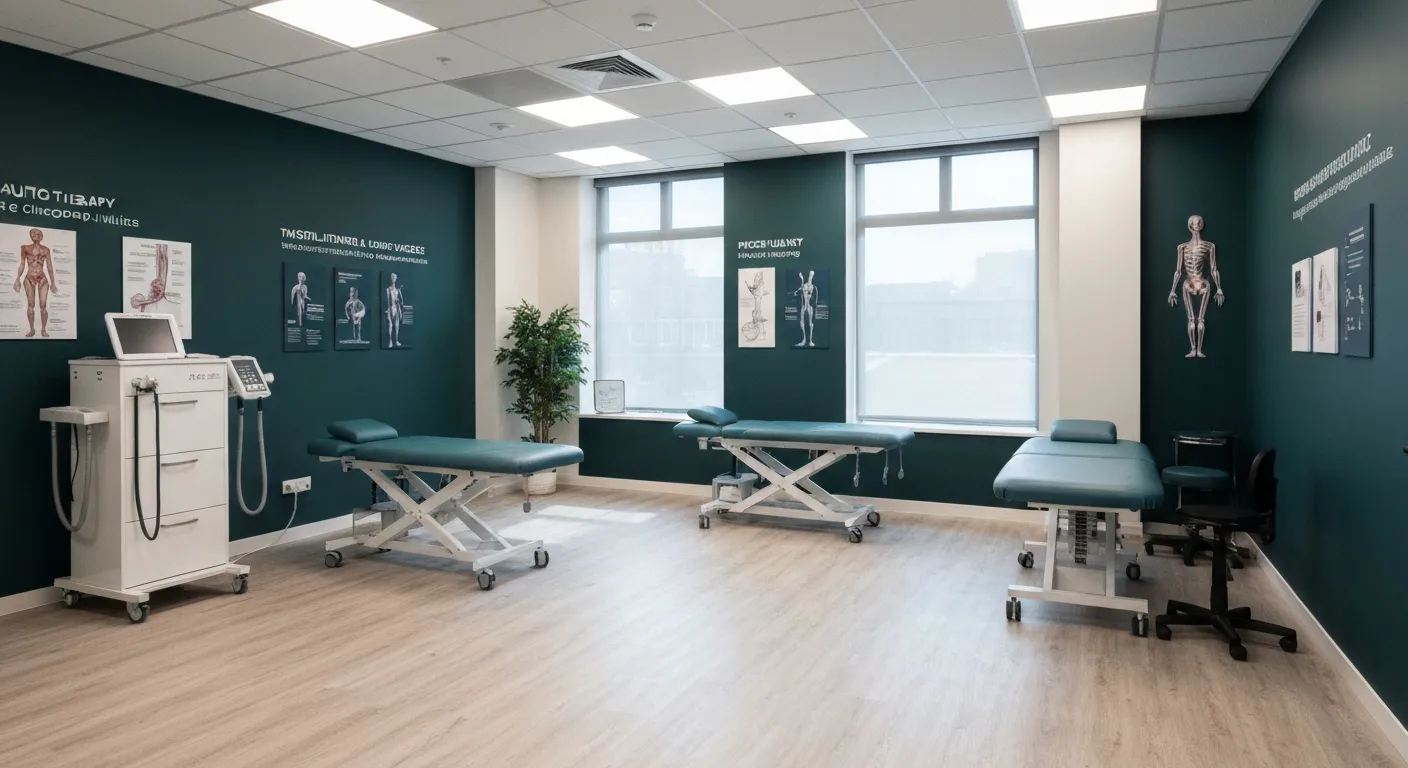How Proper Nutrition Supports Chiropractic and Physiotherapy Treatments
October 15, 2025
9 min

The Synergy Between Nutrition, Chiropractic Care, and Physiotherapy
Proper nutrition plays a pivotal role in supporting and enhancing the benefits of chiropractic and physiotherapy treatments. Both manual therapies focus on restoring musculoskeletal function and promoting healing, and nutrition complements these treatments by providing the essential nutrients required for tissue repair, inflammation reduction, and overall health. This article explores how balanced diet choices, hydration, and specific nutrients can optimize rehabilitation outcomes, promote faster recovery, and support long-term musculoskeletal wellness.
The Foundation: How Nutrition Supports Musculoskeletal Health and Healing

How does nutrition support musculoskeletal health?
Nutrition plays a vital role in keeping bones, muscles, and joints strong and healthy. It supplies the building blocks necessary for tissue repair and muscle growth, which are essential for recovery from injuries and maintaining physical function.
Role of protein, vitamins, minerals in tissue repair and muscle growth
Protein is crucial for building and repairing muscle tissues. Consuming adequate protein from sources like lean meats, fish, eggs, legumes, and dairy supports muscle maintenance and regeneration. Vitamins and minerals such as vitamin C aid collagen production, zinc assists tissue healing, and B vitamins support energy metabolism essential for muscle function (Role of Nutrition in Physical Therapy).
Importance of anti-inflammatory foods in reducing pain and swelling
Anti-inflammatory foods help reduce inflammation, pain, and swelling associated with musculoskeletal conditions. Foods rich in omega-3 fatty acids (found in fatty fish and walnuts), berries, leafy greens, and spices like turmeric and ginger contribute antioxidants that combat oxidative stress and alleviate discomfort (Anti-inflammatory Foods for Healing).
Key nutrients for bone health: calcium, vitamin D, magnesium, vitamin K1
Calcium and vitamin D are fundamental for maintaining bone density and strength. Vitamin D enhances calcium absorption, while magnesium regulates calcium balance and bone structure. Vitamin K1, abundant in leafy greens, supports bone matrix quality by activating osteocalcin, helping reduce fracture risk (Nutrition for musculoskeletal health).
Impact of hydration on spinal and joint health
Adequate hydration is essential for maintaining joint lubrication and the elasticity of spinal discs, which act as shock absorbers between vertebrae. Drinking enough water and consuming water-rich foods supports nutrient delivery and waste removal in musculoskeletal tissues, promoting flexibility and reducing injury risk (Nutrition and spinal health).
Maintaining a balanced diet rich in these nutrients alongside proper hydration forms a strong foundation for musculoskeletal health, accelerating healing and improving mobility (Nutrition and Physical Therapy).
Reducing Inflammation Through Diet: A Key to Enhancing Manual Therapy

How does diet help reduce inflammation to support chiropractic and physiotherapy?
Diet is a powerful tool for managing inflammation, which often worsens musculoskeletal pain affecting the spine, joints, and muscles. Anti-inflammatory diets include foods that help calm the body's inflammatory responses, a critical factor in pain reduction and tissue healing after chiropractic adjustments or physiotherapy. Learn more about the role of nutrition in chiropractic care and nutrition for injury recovery.
Effects of inflammatory vs. anti-inflammatory diets on musculoskeletal pain
Diets high in processed foods, sugary drinks, and excessive saturated fats tend to promote inflammation. This can increase pain, joint stiffness, and slow recovery from injuries or chronic conditions like arthritis. In contrast, diets abundant in fruits, vegetables, nuts, and fatty fish are linked to lower inflammation levels, reduced musculoskeletal pain, and better treatment outcomes. More detailed information is available on the impact of processed foods on inflammation and anti-inflammatory foods for musculoskeletal health.
Role of omega-3 fatty acids and antioxidants in inflammation management
Omega-3 fatty acids, found in fatty fish (salmon, tuna), flaxseeds, and walnuts, have potent anti-inflammatory properties. They help decrease swelling and support joint and tissue health. Antioxidants present in berries, leafy greens, and turmeric combat oxidative stress, reducing free radical damage that contributes to inflammation and chronic pain. Discover more on the benefits of omega-3 fatty acids in recovery and antioxidant-rich foods for healing.
Foods to avoid that exacerbate inflammation
Avoiding processed foods, sugary beverages, deep-fried items, and high-fat processed meats is crucial because they increase inflammatory markers. These foods can exacerbate pain, stiffen joints, and impede the healing benefits of manual therapies. For more, see inflammatory foods and their effects and diet-induced inflammation and nerve discomfort.
Benefits of diets rich in fruits, vegetables, nuts, and fatty fish
A diet rich in these nutrient-dense foods provides essential vitamins, minerals, and healthy fats that promote immune health, support tissue repair, and enhance energy. This nutritional support complements chiropractic and physiotherapy care by optimizing the body's natural healing processes and improving overall patient well-being. Learn about balanced meals for energy and recovery and the importance of nutrition in physical therapy.
| Aspect | Inflammatory Foods | Anti-inflammatory Foods | Benefits |
|---|---|---|---|
| Fatty Acids | Saturated fats, processed meats | Omega-3 rich fish, walnuts, flaxseeds | Reduce inflammation, improve joint health |
| Antioxidants | Processed snacks, sugary drinks | Berries, leafy greens, turmeric | Combat oxidative stress, reduce pain |
| Impact on Musculoskeletal | Increase pain and stiffness | Decrease pain and enhance healing | Support recovery and therapy effectiveness |
Nutritional Strategies to Accelerate Recovery and Rehabilitation

How can proper nutrition accelerate recovery during chiropractic and physiotherapy treatments?
Proper nutrition is essential for speeding up recovery and supporting rehabilitation during chiropractic and physiotherapy care. Protein plays a crucial role in this process by providing the building blocks required to repair damaged muscles and prevent muscle wasting. Intake levels are often increased post-injury or surgery to meet the higher demand for tissue synthesis (Nutrition for Injury Recovery, Nutrition and Physical Therapy.
Increased protein needs for muscle repair and to prevent atrophy
After injury or during rehabilitation, muscles are prone to atrophy due to inactivity or damage. Consuming adequate protein—ranging from 1.3 to 2.5 grams per kilogram of body weight depending on activity level—ensures muscle repair and helps maintain muscle mass (Protein and Tissue Repair, Role of Protein in Muscle Repair). High-quality protein sources include lean meats, fish, dairy, beans, nuts, and soy products (Foods Promote Healing Muscles Joints, Protein Intake Post-Therapy).
Role of vitamin C and zinc in tissue healing and collagen synthesis
Vitamin C is vital for collagen production, the main structural protein in bones, muscles, and tendons. It also has antioxidant effects that reduce inflammation. Zinc supports cell growth and immune function, crucial during the tissue healing phases (Vitamin C and Collagen Production, Zinc for Tissue Healing). Foods rich in vitamin C, such as oranges, kiwis, and broccoli, alongside zinc sources like shellfish, meat, nuts, and whole grains, should be included in recovery diets (Healing Foods after Physiotherapy).
Importance of calorie and nutrient adequacy especially post-injury or surgery
Adequate energy intake is critical as low calorie consumption can slow healing and reduce immune function. Nutrient-dense foods supply essential vitamins, minerals, and antioxidants for repair and reduce inflammation (Nutrition for Optimal Recovery, Anti-inflammatory Foods for Healing. Emphasizing a balanced diet with carbohydrates, proteins, and healthy fats ensures sufficient energy to fuel rehabilitation processes (Balanced Meals for Energy and Recovery).
The synergy between nutrition, hydration, and physical activity in recovery
Nutrition works hand-in-hand with hydration and exercise to optimize healing. Hydration supports cellular metabolism and maintains the health of intervertebral discs important in spinal recovery (Hydration and Spinal Health, Hydration Importance in Injury Recovery). Physical activity, guided by physiotherapy or chiropractic care, improves circulation, muscle strength, and flexibility (Exercise and Chiropractic Care, Physical Therapy and Nutrition Integration. Adequate nutrition provides the raw materials that support these bodily adaptations and promote long-term rehabilitation success (Holistic Approach to Nutrition and Chiropractic.
Integrating Nutrition and Manual Therapy for Holistic Health

How are nutrition and chiropractic or physiotherapy treatments integrated in practice?
Chiropractors and physical therapists often incorporate nutritional counseling into their treatment plans as part of a holistic approach. They provide guidance on anti-inflammatory diets and nutrient-rich foods that support musculoskeletal health and reduce inflammation. Common recommendations include foods rich in omega-3 fatty acids, vitamin D, calcium, and antioxidants. Supplementation—with omega-3s, vitamin D, magnesium, and probiotics—is frequently suggested to fill nutritional gaps that support nerve health, tissue repair, and immune function.
Use of dietary supplements to fill nutrient gaps
Dietary supplements complement dietary advice by targeting specific deficiencies that may hinder recovery. For example, omega-3 fatty acids help reduce inflammation around joints and the spine, magnesium supports muscle relaxation, and vitamin D aids calcium absorption for strong bones. Probiotics promote gut health, which is linked to overall healing efficiency. These supplements are often prescribed carefully and tailored to individual patient needs.
Benefits of personalized dietary guidance and multi-disciplinary care
Personalized nutrition plans are integral to optimizing treatment outcomes alongside manual therapy. Many practitioners collaborate closely with registered dietitians to tailor diets based on medical history, lifestyle, and therapy goals. This multidisciplinary care improves recovery speed, reduces chronic inflammation, and enhances patients’ energy and vitality as supported by evidence-based nutrition advice in chiropractic care. Patients often experience better pain management, longer-lasting chiropractic benefits, and improved rehabilitation results from physical therapy.
Addressing weight management and systemic health for musculoskeletal benefits
Maintaining a healthy weight through nutrition is a critical component that reduces stress on weight-bearing joints like hips and knees. This alleviates pain and prevents premature wear and tear, thereby improving mobility and supporting manual therapy benefits. Additionally, controlling systemic health factors, such as inflammation and metabolic conditions through diet, contributes to stronger bones, muscles, and nerves—foundational elements for effective chiropractic and physiotherapy care.
Lifestyle Synergy: Combining Nutrition, Exercise, and Manual Care for Optimal Outcomes
Physical activity’s role in supporting nutritional benefits
Engaging in regular physical activity is crucial for complementing the benefits provided by a nutritious diet. Exercise enhances cardiovascular health, promotes efficient blood flow, and strengthens muscles and joints. These improvements support the body's ability to utilize nutrients effectively, aiding tissue repair and recovery, especially following physical therapy or chiropractic care.
How exercise enhances cardiovascular, muscular, and joint health alongside diet
Exercise not only builds muscular strength and flexibility but also reduces stress on joints and the spine. This synergizes with proper nutrition, which supplies essential proteins, vitamins, and minerals needed for musculoskeletal health. Together, they optimize healing and maintain proper posture and mobility, reducing the risk of chronic pain and injury (Nutrition and Physical Therapy, Nutrition's role in chiropractic care).
Hydration and mindful eating practices in recovery
Adequate hydration is vital for maintaining the elasticity of spinal discs and supporting nutrient transport throughout the body. Mindful eating fosters better digestion and nutrient absorption, which further boosts the body's healing processes (Nutrition and Chiropractic Care, Hydration importance in injury recovery. These habits reinforce the positive effects of chiropractic adjustments and physiotherapy sessions.
Long-term benefits of combining nutrition with chiropractic and physiotherapy
A holistic approach that integrates balanced nutrition, targeted exercise, and manual therapies results in faster recovery times, reduced inflammation, and improved overall well-being. This combination not only supports injury rehabilitation but also fosters prevention strategies, ensuring sustained musculoskeletal health and enhanced quality of life over time (Integrating Nutrition with Chiropractic Care, Nutrition for Injury Recovery.
| Lifestyle Factor | Role in Recovery | Benefit Description |
|---|---|---|
| Physical Activity | Supports cardiovascular and muscular health | Enhances nutrient use and spine stability (Nutrition and Physical Therapy |
| Proper Nutrition | Provides essential nutrients | Fuels tissue repair and reduces inflammation (Anti-inflammatory Foods for Healing |
| Hydration | Maintains spinal disc health | Facilitates nutrient transport and healing (Hydration and spinal health |
| Mindful Eating | Improves digestion and nutrient absorption | Aids in efficient recovery and wellness (Mindful Eating Benefits
The Integral Role of Nutrition in Supporting Manual Therapies
Nutrition is a foundational pillar that complements chiropractic and physiotherapy treatments by fueling the body’s healing processes, reducing inflammation, and supporting musculoskeletal integrity. A balanced diet rich in anti-inflammatory foods, sufficient protein, essential vitamins and minerals, and adequate hydration creates an optimal internal environment for manual therapies to work effectively. Integrating tailored nutritional guidance with rehabilitative exercises and chiropractic care fosters faster recovery, pain reduction, and longevity of treatment benefits. Embracing a holistic lifestyle that includes proper nutrition alongside physical therapy and chiropractic adjustments ultimately enhances patient outcomes and promotes lifelong musculoskeletal health.
Recent articles

Sciatica Relief Through Targeted Spinal Decompression

Integrating Physiotherapy with Chiropractic Treatments for Better Results

Testimonials That Demonstrate the Benefits of Chiropractic Care

The Power of Corrective Exercises in Pain Management

A Step-by-Step Guide to Your Initial Chiropractic Consultation

9 Nutritional Tips to Enhance Your Chiropractic Wellness Journey

Patient Experiences: How Chiropractic Care Changed Their Lives

Lifestyle Recommendations to Keep Your Spine in Top Shape

Effective Corrective Exercises for Long-Term Pain Relief

Back Pain Benefits: What Chiropractic Care Can Do for You

Spinal Decompression Techniques for Effective Sciatica Relief

Top Nutritional Counseling Tips for Enhanced Wellness

6 Lifestyle Habits That Boost Spine Health Daily

Discover Holistic and Non-Surgical Pain Relief Solutions

Exploring Holistic and Non-Surgical Treatment Options for Pain

The Role of Physiotherapy in Enhancing Chiropractic Care Outcomes

Complementing Chiropractic Care with Physiotherapy: What You Need to Know

What to Expect During Your First Chiropractic Visit

Simple Lifestyle Adjustments to Maintain a Healthy Spine

Personalized Nutritional Counseling for Improved Health Outcomes

Exploring Non-Surgical Treatments for Spine-Related Conditions

An Introduction to Spinal Decompression for Sciatica Patients

Transformative Success Stories: Patient Experiences with Chiropractic Treatments

Why Chiropractic Care Is Essential for Back Pain Relief

Addressing Underlying Causes Versus Symptom Management in Pain Care

The Role of Nutrition in Enhancing Chiropractic Treatment Effectiveness

Sciatica Treatment Options: Is Spinal Decompression Right for You?

Lifestyle Tips to Maintain a Healthy Spine and Prevent Back Issues

The Synergy Between Physiotherapy and Chiropractic Treatments

What Happens During Your Initial Chiropractic Consultation

Effective Corrective Exercises for Sustainable Pain Management

Taking a Root Cause Approach to Chronic Pain Management

Holistic Pain Management Techniques Without Surgery

How Patient Success Stories Validate Chiropractic Care Benefits

Spinal Decompression: Innovative Treatment for Sciatic Nerve Pain

Spinal Decompression Therapy: A Non-Invasive Approach to Sciatica Relief

Exploring Holistic Approaches Beyond Surgery for Pain Relief

Practical Lifestyle Advice to Support a Healthy Spine Every Day

Corrective Exercise Routines Designed for Long-Term Pain Prevention

Real Patient Stories: Overcoming Chronic Pain with Chiropractic Care

Lifestyle Changes That Promote a Healthy Spine and Prevent Injury

How Addressing the Root Cause of Pain Leads to Lasting Relief

Non-Surgical Holistic Therapies to Manage Chronic Pain Effectively

Nutritional Counseling's Impact on Physical Health and Healing

Benefits of Regular Chiropractic Care for a Stronger Back

Your First Chiropractic Visit: What to Expect and How to Prepare

Patient Experiences: How Chiropractic Care Transformed Their Lives

Exploring Holistic, Non-Surgical Options for Pain Management

Combining Physiotherapy with Chiropractic Treatments for Enhanced Recovery

Holistic Treatments That Offer Alternatives to Surgery for Pain Relief

Corrective Exercise Strategies for Long-Term Spine Health

How Physiotherapy Complements Chiropractic Adjustments for Better Outcomes

First-Time Chiropractic Visitors: What You Should Know

Understanding the Importance of Treating Pain at Its Source

Adopting Lifestyle Changes to Support Your Spine's Wellness

Utilizing Physiotherapy to Enhance Chiropractic Treatment Outcomes

The Key Advantages of Chiropractic Care for Back Pain Sufferers

Why Focusing on Root Causes Improves Pain Treatment Success

Corrective Exercises That Promote Lasting Pain Relief and Mobility

Sciatica Relief Through Targeted Spinal Decompression Techniques

Preparing for Your First Chiropractic Appointment with Confidence

Healthy Lifestyle Habits for Maintaining Spinal Alignment

Success Stories Highlighting Chiropractic's Role in Pain Recovery

Top Benefits of Chiropractic Care for Chronic Back Pain

Nutrition Tips to Boost Your Overall Wellness and Recovery

How Chiropractic Care Alleviates Back Pain Naturally

How Nutritional Counseling Supports Overall Wellness and Spine Health

Step-by-Step Guide to Your First Visit with a Chiropractor

Using Nutrition to Support Chiropractic and Overall Wellness

Integrating Physiotherapy in Your Chiropractic Healing Journey

How Physiotherapy Complements Chiropractic Adjustments for Faster Healing

Lifestyle Tips for Maintaining a Healthy Spine and Preventing Back Pain

Heartwarming Patient Testimonials Highlighting Chiropractic Success

How Proper Nutrition Supports Chiropractic and Physiotherapy Treatments

Combining Physiotherapy and Chiropractic Treatments for Optimal Recovery

Why Chiropractic Treatments Are Effective for Managing Back Pain

Choosing a Chiropractor: Tips for Finding a Trusted Provider

Integrating Physiotherapy and Chiropractic: Benefits and What to Expect

How Tailored Corrective Exercises Can Aid in Pain Management

Chiropractic Care: A Proven Solution for Alleviating Back Pain

What to Expect at Your First Chiropractic Visit: A Comprehensive Guide

The Importance of Root Cause Analysis in Effective Pain Management

The Role of Corrective Exercises in Sustaining Pain-Free Living

Combining Chiropractic and Physiotherapy for Comprehensive Pain Relief

How Addressing Underlying Causes Improves Pain Treatment Effectiveness

Maintaining Spinal Health Through Lifestyle Changes and Preventive Care

Understanding the Benefits of Chiropractic Adjustments for Back Pain Sufferers

Spinal Decompression Therapy: A New Hope for Sciatica Relief

Lifestyle Recommendations to Support a Healthy Spine and Reduce Pain

Choosing the Right Chiropractor: Key Factors to Consider Before Your First Appointment

Non-Invasive Treatment Alternatives: A Holistic Approach to Pain Relief

Corrective Exercises to Support Long-Term Relief from Chronic Pain

Exploring Non-Surgical Approaches to Spine Health and Wellness

Tips for Daily Habits That Keep Your Spine Strong

Success Stories: How Chiropractic Treatments Changed Lives

Why Focusing on the Root Cause of Pain Leads to Better Outcomes

Nutritional Counseling and Its Impact on Overall Wellness and Recovery

Patient Testimonials That Showcase the Power of Chiropractic Care

Preparing for Your First Chiropractic Appointment: What You Need to Know

